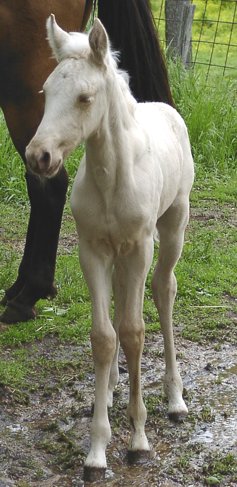White horse
White horse refers to any horse characterized by a coat color that includes a significant amount of white hair and may refer to several different types of coat coloration in horses. A true white horse is born white and remains white throughout its life. This is a result of the horse having a dominant gene that suppresses the production of pigment in the hair, leading to a completely white coat. However, many horses that appear white are actually gray horses that have progressively lost their pigmented hair with age, a process that can start as early as one year of age.
Types of White Coats in Horses[edit | edit source]
There are several conditions and genetic variations that can result in a horse appearing white:
- True White: These horses have pink skin and white coats from birth. They often have blue or brown eyes. This is a rare condition caused by a dominant allele of a gene that inhibits pigmentation.
- Gray: Gray horses are born with a pigmented coat that lightens as they age, often becoming completely white. They have dark skin underneath their white hair. This is the most common reason for a horse to appear white.
- Cremello and Perlino: These horses have a coat color that results from a double dose of the cream dilution gene on a base of chestnut or bay, respectively. They are not true whites, as their coats have a creamy hue, but they can appear white from a distance.
- Dominant White: This is a genetic condition that results in white or nearly white coats from birth. Unlike true white horses, dominant white horses can have pigmented patches along with their white coats.
- Sabino: Some horses with the sabino pattern can be so extensively white that they appear to be completely white, though they are genetically patterned horses.
Genetics[edit | edit source]
The genetics behind white coat color in horses are complex and involve multiple genes. The true white coat is believed to be controlled by a not fully understood genetic mechanism that is distinct from the one causing the gray coat color. The gray gene (symbolized as G) is dominant, meaning that only one copy of the gene is required for the horse to turn gray. The process of graying can result in a horse that is completely white by middle age. In contrast, the genetics of true white horses, cremellos, perlinos, and dominant whites involve different genetic mechanisms.
Care and Health Considerations[edit | edit source]
White and light-colored horses require special care to protect their skin from sunburn and to monitor for signs of skin cancer, which they may be more prone to than darker horses. Their eyesight is not affected by their coat color, although horses with blue eyes, often found in white-coated breeds, may be slightly more sensitive to bright light.
Cultural Significance[edit | edit source]
White horses have held a special place in many cultures throughout history, symbolizing purity, heroism, and status. They have been featured prominently in mythology, folklore, and heraldry. In some cultures, white horses are considered to be lucky and are associated with heroic figures or deities.
Navigation: Wellness - Encyclopedia - Health topics - Disease Index - Drugs - World Directory - Gray's Anatomy - Keto diet - Recipes
Search WikiMD
Ad.Tired of being Overweight? Try W8MD's physician weight loss program.
Semaglutide (Ozempic / Wegovy and Tirzepatide (Mounjaro / Zepbound) available.
Advertise on WikiMD
WikiMD is not a substitute for professional medical advice. See full disclaimer.
Credits:Most images are courtesy of Wikimedia commons, and templates Wikipedia, licensed under CC BY SA or similar.Contributors: Prab R. Tumpati, MD





